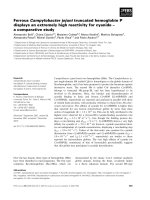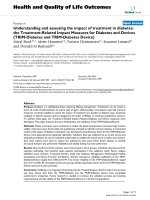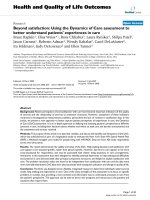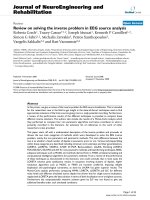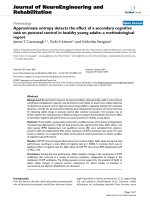báo cáo hóa học:" Difficulty in diagnosing the pathological nature of an acute fracture of the clavicle: a case report" ppt
Bạn đang xem bản rút gọn của tài liệu. Xem và tải ngay bản đầy đủ của tài liệu tại đây (442.63 KB, 4 trang )
BioMed Central
Page 1 of 4
(page number not for citation purposes)
Journal of Orthopaedic Surgery and
Research
Open Access
Case report
Difficulty in diagnosing the pathological nature of an acute fracture
of the clavicle: a case report
Sheraz S Malik*
1
, Saiqah Azad
2
, Shahbaz Malik
3
and Caroline B Hing
1
Address:
1
Department of Trauma & Orthopaedics, Watford General Hospital, West Hertfordshire Hospitals NHS Trust, Watford, UK,
2
Department
of Medicine, Watford General Hospital, West Hertfordshire Hospitals NHS Trust, Watford, UK and
3
Department of Trauma & Orthopaedics, Barnet
General Hospital, Barnet & Chase Farm Hospitals NHS Trust, Barnet, UK
Email: Sheraz S Malik* - ; Saiqah Azad - ; Shahbaz Malik - ;
Caroline B Hing -
* Corresponding author
Abstract
Fractures of the clavicle comprise between 5% to10% of all fractures. Medial clavicular fractures
are uncommon and are normally caused by high-energy trauma. A low impact mechanism of injury
should raise suspicion of a pathological fracture, but this case report highlights the difficulty in
diagnosing the pathological nature of an acute fracture of the clavicle. We describe a patient who
presented with a medial clavicular fracture after a simple fall but the fracture was diagnosed as
pathological in retrospect four months after the initial presentation. We would also like to
emphasise that the medial clavicle is the most frequent site of pathological fractures of the clavicle,
and the possibility of an underlying pathological condition should be considered whenever a patient
with a medial clavicular fracture is encountered.
Background
The incidence of clavicular fractures in adults is 30 per 100,
000 population per year [1] and these are one of the most
commonly encountered fractures in the accident & emer-
gency (A&E) department and orthopaedic practice [2]. Most
clavicular fractures are caused by a fall or direct trauma to the
shoulder. The clavicle is vulnerable to pathological fractures
from several causes such as neoplasm, infection and meta-
bolic bone disease [3]. We describe a patient who presented
with a medial clavicular fracture after a trivial activity, but the
fracture was diagnosed as pathological in retrospect four
months after the initial presentation. To the best of our
knowledge, the delay that can occur between the first presen-
tation of an acute clavicular fracture and recognition that it is
in fact pathological has not been specifically highlighted pre-
viously in the literature.
Case presentation
Case report
A 67-year old woman presented to the A&E department
complaining of pain in her left shoulder and clavicle that
started whilst lifting a flowerpot in the garden. She also
recalled having fallen from a stepladder a few days before
but denied any apparent injury resulting from this. On
examination, there was swelling and tenderness over the
medial aspect of the left clavicle, and no associated neu-
rovascular deficit. The rest of the shoulder examination
was normal. A plain radiograph of her left shoulder
revealed an undisplaced fracture of the medial clavicle
(figure 1). She was placed in a broad arm sling and dis-
charged from the A&E department with a follow-up
appointment in the fracture clinic.
Published: 25 June 2009
Journal of Orthopaedic Surgery and Research 2009, 4:21 doi:10.1186/1749-799X-4-21
Received: 10 May 2009
Accepted: 25 June 2009
This article is available from: />© 2009 Malik et al; licensee BioMed Central Ltd.
This is an Open Access article distributed under the terms of the Creative Commons Attribution License ( />),
which permits unrestricted use, distribution, and reproduction in any medium, provided the original work is properly cited.
Journal of Orthopaedic Surgery and Research 2009, 4:21 />Page 2 of 4
(page number not for citation purposes)
One week later, the patient was reviewed in the fracture
clinic by an orthopaedic registrar who attributed the pain,
swelling and the fracture of the clavicle to the mechanism
of injury and advised follow-up in one month's time.
The patient failed to attend the follow-up appointment
and was discharged from the clinic because of non-attend-
ance. Four months later the patient was referred by the GP
to the orthopaedic clinic with an enlarging lump over the
fracture site. In the clinic she was systemically well with no
concerning symptoms other than an enlarging swelling at
the fracture site. She gave a past medical history of hyper-
tension, a left mastectomy for breast cancer eight years
ago, and admitted to smoking for many years. On exami-
nation there was a large, mildly tender bony lump at the
fracture site, and a repeat radiograph of the left shoulder
revealed a large lytic lesion over the medial aspect of the
clavicle (figure 2). This was considered malignant and
urgently investigated further. A computed tomography
(CT) scan of the thorax, abdomen and pelvis revealed a
right renal tumour with metastases to the lungs, liver and
bone. The bone metastases were to the left clavicle and the
right ilium. A further two-phase technetium-99m-methyl-
ene diphosphonate (Tc99M MDP) bone scan confirmed
only two bone metastases (figure 3), and an open biopsy
of the clavicle revealed a metastatic renal cell carcinoma.
The patient was referred to a medical oncologist for fur-
ther staging and treatment.
Discussion
Medial clavicular fractures are the least common of clavic-
ular fractures, comprising between 2% to 10% of all cla-
vicular fractures [1,4,5]. Postacchini et al found that the
incidence of medial clavicular fractures increases in the
elderly, comprising 2% of clavicular fractures in 18–30
years age group and 10% of clavicular fractures in 61–80
years age groups [4]. All clavicular fractures are more com-
mon in men, and in Robin's case series of 1000 clavicular
fractures the male to female ratio for medial clavicular
fracture was 3.7:1 [1]. Acute medial clavicular fractures are
commonly caused by high-energy trauma and are associ-
ated with other multisystem injuries [5].
Renal cell carcinoma accounts for 2% of all malignancies.
Up to a third of patients with renal cell carcinoma develop
bone metastases [6], most of which are lytic and predom-
inantly affect the axial skeleton [7]. Clavicular metastases
comprise 6–18% of all bone metastases from renal cell
carcinoma [6-8]. Swanson et al found that the symptoms
secondary to bone metastases were the presenting com-
plaint that subsequently led to a diagnosis of renal cell
carcinoma in 121 of 252 (48%) patients [8]. In their
study, 37 patients presented with a pathological fracture
and an additional 34 patients experienced a pathological
fracture in the course of the disease.
Plain radiograph of the left shoulder at the first presentationFigure 1
Plain radiograph of the left shoulder at the first pres-
entation. The radiograph demonstrates a medial clavicular
fracture (arrow) that was later diagnosed as pathological.
Plain radiograph of the left shoulder taken 4 months laterFigure 2
Plain radiograph of the left shoulder taken 4 months
later. The radiograph demonstrates a large lytic lesion
(arrow) over the medial aspect of the clavicle.
A Tc99M MDP Bone ScanFigure 3
A Tc99M MDP Bone Scan. The bone scan demonstrates
bone metastases to the left medial clavicle and the right ilium
(arrows).
Journal of Orthopaedic Surgery and Research 2009, 4:21 />Page 3 of 4
(page number not for citation purposes)
The medial clavicle is the most frequent site of pathologi-
cal fractures in the clavicle [3]. A pathological fracture
occurs in a bone that is not normal [9]. Failure to recog-
nise and appropriately treat a pathological fracture and
the associated underlying condition can be detrimental to
the patient's life or the affected limb [9]. This case report
demonstrates the difficulty in diagnosing a pathological
fracture of the clavicle. The patient in this case was treated
for a primary non-pathological fracture of the clavicle and
the proper diagnosis was made four months after the
patient's initial presentation. Clinicians are alert to sus-
pecting a pathological fracture in unusual circumstances
of injury in bones such as vertebrae and long bones of the
limbs. However, clavicular fractures are common in all
age groups and occur due to various types of injury and
variable-energy trauma. These fractures are not routinely
suspected to be pathological, unless associated with obvi-
ous clinical or radiological features of an underlying dis-
ease. Therefore clavicular fractures are not routinely
investigated for an underlying pathological condition.
This can result in a considerable time lag between the first
presentation of the clavicular fracture and recognition that
it is in fact pathological. Furthermore, an unclear history
or a history of multiple accidents e.g. falls, can confound
the actual cause of the fracture. In the patient that we
described the fracture was attributed to the old fall but she
in fact had an atraumatic pathological fracture of the clav-
icle.
Adeyemo et al described a similar case where a 73 year old
man was seen in A&E and then followed up in a fracture
clinic for a left medial clavicular fracture after a fall on to
the left shoulder [10]. Six weeks after the first presentation
he was found to have clinical and radiological signs of
"huge callus formation" at the fracture site, and was given
a 3-month follow up appointment. He was admitted to
hospital with obstructive jaundice before this, and at his
follow up appointment he was found to have a clavicle
swelling the size of an orange and complete radiological
destruction of the medial clavicle. A diagnosis of underly-
ing metastatic bronchogenic carcinoma was later estab-
lished. It was after over 4 months since first presentation
that the pathological nature of the clavicular fracture was
appreciated in retrospect.
To the best of our knowledge, this is the first time that the
delay that can be associated with diagnosing the patho-
logical nature of an acute clavicular fracture has been spe-
cifically brought to light. Adeyemo et al put this delay
down to the "compartmentalised" treatment that their
patient received from multiple health care professionals
[10], but it is now emerging that this could be a feature
common to acute pathological clavicular fractures as a
group. Of course, many such fractures are diagnosed
promptly, and may not necessarily be reported in the lit-
erature. However the delay that can occur is a significant
one, four months or more in the two cases discussed
above, and this has been highlighted with the aim of rais-
ing awareness in all cases.
A high index of suspicion is required to consider a clavic-
ular fracture as pathological. For this reason, a full medi-
cal history should always be taken at the time of assessing
a patient with a fracture. Information such as past medical
history of carcinoma can raise a high index of suspicion of
a pathological fracture. Other features in the history that
could suggest a pathological fracture include a patient
above the age of 45 years, multiple recent fractures or pain
at the site before the fracture [9]. Such patients should also
have a thorough physical examination of the upper limbs,
the rest of the skeletal system to check for other affected
sites, and a general examination of possible primary sites
such as breast, prostate, thyroid and lymph nodes for lym-
phoma [9].
The clinical finding would direct further urgent investiga-
tions, and may include further imaging of the clavicle with
cone views and upper rib radiographs or a CT scan to ade-
quately delineate the fracture and the quality of the sur-
rounding bone [11]. Adjunct investigations include
laboratory studies such as full blood count, erythrocyte
sedimentation rate, bone profile, prostate-specific anti-
gen, immunoelectrophoresis and alkaline phosphatase,
urine analysis for Bence-Jones proteins, CT scan of the
thorax, abdomen and pelvis, total body bone/positron
emission tomography (PET) scan and biopsy of the frac-
ture site and/or the primary site if appropriate [9].
It is important that patients with a suspected pathological
clavicular fracture are discussed in a multi-disciplinary set-
ting and reviewed for features of radiographic union,
unlike the patient that we described, who was discharged
after failing to attend an appointment.
Conclusion
We would like to emphasize that all patients should be
carefully assessed on an individual basis, including those
who present with apparently common simple injuries. We
would also like to highlight that medial clavicular frac-
tures are separate from other clavicular fractures because
these are uncommon, normally associated with high-
energy trauma and occur where pathological fractures in
the clavicle are most common. Therefore, the possibility
of an underlying pathological condition should be con-
sidered whenever a patient with a medial clavicular frac-
ture is encountered.
Consent
Written informed consent was obtained from the patient
for publication of this case report and any accompanying
Publish with BioMed Central and every
scientist can read your work free of charge
"BioMed Central will be the most significant development for
disseminating the results of biomedical research in our lifetime."
Sir Paul Nurse, Cancer Research UK
Your research papers will be:
available free of charge to the entire biomedical community
peer reviewed and published immediately upon acceptance
cited in PubMed and archived on PubMed Central
yours — you keep the copyright
Submit your manuscript here:
/>BioMedcentral
Journal of Orthopaedic Surgery and Research 2009, 4:21 />Page 4 of 4
(page number not for citation purposes)
images. A copy of the written consent is available for
review by the Editor-in-Chief of this journal.
Competing interests
The authors declare that they have no competing interests.
Authors' contributions
SSM conceived the idea and wrote the paper.
SA and SM analysed the notes and contributed to the dis-
cussion.
CBH was responsible for editing and approving the final
manuscript.
All authors read and approved the final manuscript.
References
1. Robinson CM: Fractures of the clavicle in the adult. Epidemi-
ology and classification. J Bone Joint Surg Br 1998, 80:476-84.
2. Kim W, McKee MD: Management of acute clavicle fractures.
Orthop Clin North Am 2008, 39:491-505.
3. Lazarus MD, Seon C: Fractures of the clavicle. In Rockwood and
Green's fractures in adults 6th edition. Edited by: Bucholz RW, et al.
Philadelphia, PA: Lippincott Williams & Wilkins; 2006:1211-1256.
4. Postacchini F, Gumina S, De Santis P, Albo F: Epidemiology of clav-
icle fractures. J Shoulder Elbow Surg 2002, 11:452-6.
5. Throckmorton T, Kuhn JE: Fractures of the medial end of the
clavicle. J Shoulder Elbow Surg 2007, 16:49-54.
6. Zekri J, Ahmed N, Coleman RE, Hancock BW: The skeletal meta-
static complications of renal cell carcinoma. Int J Oncol 2001,
19:379-82.
7. Swanson DA, Orovan WL, Johnson DE, Giacco G: Osseous metas-
tases secondary to renal cell carcinoma. Urology 1981,
18:556-61.
8. Buzaid AC, Todd MB: Therapeutic options in renal cell carci-
noma. Semin Oncol 1989, 16(1 Suppl 1):12-9.
9. Weber KL: Pathological fractures. In Rockwood and Green's frac-
tures in adults 6th edition. Edited by: Bucholz RW, et al. Philadelphia,
PA: Lippincott Williams & Wilkins; 2006:643-666.
10. Adeyemo f, Babu L, Suneja R, Ellis D: Pathological fracture of the
clavicle: a case report of an unusual presentation. J Bone Joint
Surg Br 2005, 88-B(SUPP_II):302.
11. Simon RR, Sherman SC, Koenigsknecht SJ: Emergency Orthopae-
dics – The extremities. 5th edition. Chicago, IL: The McGraw-Hill
Companies; 2007:285-287.
